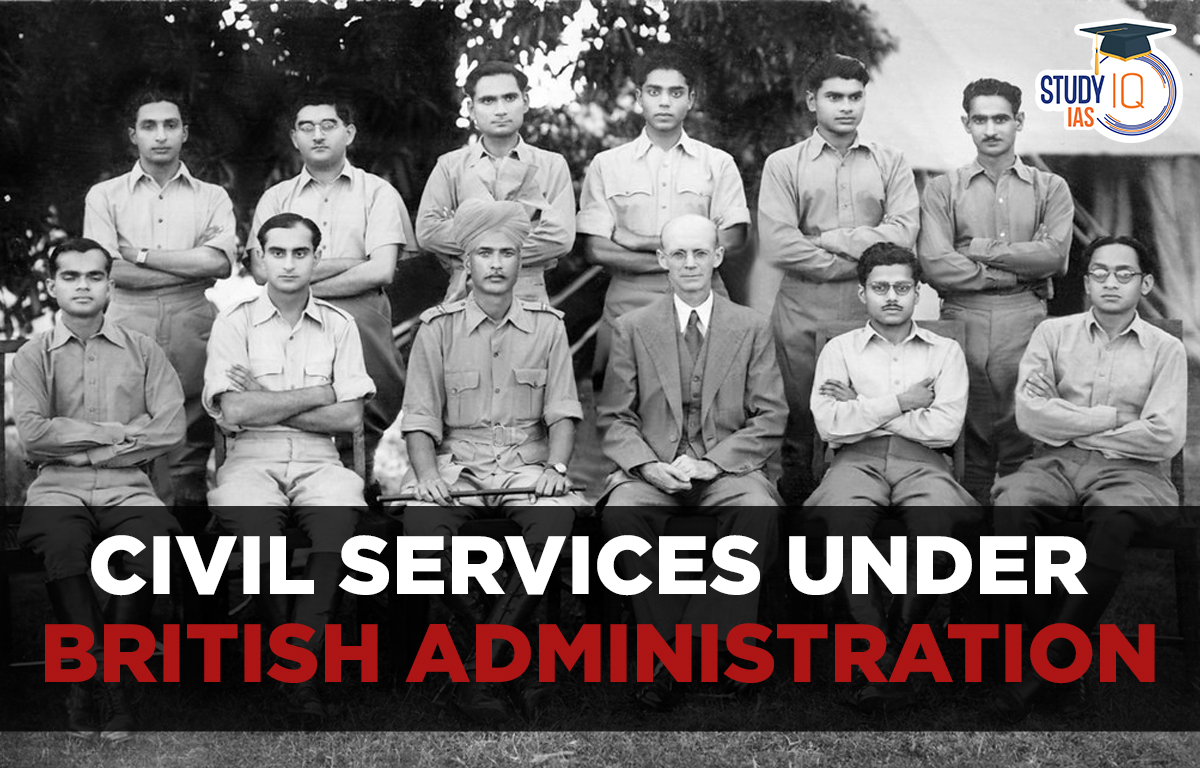Table of Contents
Civil Service under British Administration
Civil Service under British Administration was established for the benefit of its commercial affairs and developed into a well-organized apparatus to handle the administrative affairs of India’s acceded territories. In fact, the phrase “civil service” was originally used to distinguish between the Company’s employees working in the military and naval services from those working in commercial matters. Government employees gradually acquired more power and responsibility. This post will address the Indian civil service, which is beneficial for preparing for the UPSC Exam.
Civil Service under British Administration History
The East India Company served as the de facto ruler in a number of Indian provinces during the years immediately after 1757, which are when the civil service in India first began. Covenanted Civil Services was established by the business (CCS). The board of the corporation requires covenants to be signed by CCS members.
Around the Revolt of 1857, when the company’s rule came to an end and control was returned to the British Crown, or after 1886, the service assumed the name Imperial Civil Service. The Indian Civil Service was the name given to it later.
The Macaulay Committee advocated for the establishment of a merit-based system in place of the company’s patronage-based system of appointment to the service in 1854. Only competitive exams were used after 1855 to select applicants for the ICS based on merit. Only Indians were allowed to use it.
The Sir Charles Umpherston Aitchison-led Aitchison Commission suggested in 1886 that Indians work in the public sector. When the Islington Commission suggested that they hold 25% of the higher-level jobs, it further drove Indians into the service. Additionally, it suggested that higher-level hires be made in both India and England.
India began administering the ICS test in 1922. The Public Service Commission of India, which was the forerunner to the Union Public Service Commission, was established on October 1st, 1926, under the direction of Sir Ross Barker. All India Services received Central Superior Services in 1924. Due to the shortage of Europeans after 1939, there were more Indians in the military. The Indian Administrative Service (IAS) was given a new name when India gained independence.
Read More: British Administration System
Civil Service under British Administration Evolution
1. Ancient India
According to Kautilya’s Arthasastra, the administrative apparatus comprises seven fundamental components: the ruler Swamin, the bureaucracy Amatya, the territory Janapada, the fortified capital Durga, the treasury Kosa, the army Danda, and the Mitra (the ally). According to Arthasastra, mantrins and amatyas formed comprised the higher bureaucracy. The King’s top advisers were the mantrins, while his aides were the amatyas.
2. Medieval Period
During the Mughal era, the bureaucracy was managed using the mansabdari system. In essence, the mansabdari system was a pool of public servants that could be used for either civil or military purposes.
3. During British Period
The British Indian civil services saw considerable changes as a result of the adoption of Macaulay’s Report in 1835. In order to advance the interests of the British empire, the Macaulay Report suggested that only the brightest individuals be appointed to the Indian Civil Service.
4. Post-Independence
After India gained independence, parts of the British framework were still present in the civil services system. It brought together the administrative structure, an open-entry system based on academic accomplishments, and tenure for life.
Civil Service under British Administration and Role of Cornwallis
The civil services were first established and organized by Cornwallis, who served as governor-general from 1786 until 1793. Raising government worker pay, rigidly enforcing regulations against private trade, forbidding civil servants from accepting gifts, bribes, and the like and requiring promotions based on seniority were all efforts he made to combat corruption.
Civil Service under British Administration and Reforms
1. Charter Act, 1853
The Charter Act of 1853, which required that future hiring be done through an open competition, ended the Company’s patronage. On the other side, Indians were prohibited from prominent posts from the beginning. Cornwallis reasoned that “every native of Hindustan is corrupt.” All positions paying 500 pounds annually were set aside for the Company’s covenanted servants by the Charter Act of 1793.
Read about: Charter Act of 1833
2. Statutory Civil Service
In 1878–1879, Lytton formed the Statutory Civil Service, with Indians of high families filling one-sixth of covenanted jobs through local government nominations, subject to ratification by the secretary of state and the viceroy. But the program was a failure, and it was abandoned.
3. Aitchison Commission, 1886
A commission headed by Sir Charles Aitchison was established in 1886 to come up with a strategy for including Indians in all areas of government service. It was planned to look into the subject of Indian employment, including both uncovenanted service involving lower-level administrative appointments and jobs typically reserved by law for members of the covenanted civil service.
The Commission rejected the proposal to alter the covenanted civil service’s recruitment process. The Statutory Civil Service should be abolished, and the civil services should be divided into three categories: Provincial, subordinate, and imperial.
4. Montford Reform, 1919
Three levels of service classification were recommended by the Government of India Act of 1919 on Constitutional Reforms: All India, Provincial, and Subordinate. The term “All India Services” was used to describe all imperial services present at the period in the provinces, whether in reserved or transferred departments. In terms of dismissal, pay, pensions, and other rights, All India Services employees received special protections. The Act advocated the creation of a Public Service Commission charged with hiring for the service as a defense against political interference.
5. Lee Commission, 1924
Three levels of service classification were recommended by the Government of India Act of 1919 on Constitutional Reforms: All India, Provincial, and Subordinate. The term “All India Services” was used to describe all imperial services present at the period in the provinces, whether in reserved or transferred departments. In terms of dismissal, pay, pensions, and other rights, All India Services employees received special protections. The Act advocated the creation of a Public Service Commission charged with hiring for the service as a defense against political interference.
6. Government of India Act, 1935
A Federal Public Service Commission and a Provincial Public Service Commission were suggested to be established within their respective domains under the 1935 Act. Positions of power and authority, however, remained in British hands, and the civil service’s process of “Indianization” did not provide Indians real political power because Indian officials worked as proxies for colonial administration.
Civil Service under British Administration UPSC
Although not in a structured manner, civil services have existed for centuries. Later, with the entry of the East India Company, a group of men known as factors who conducted its business made up the civil service. The civil service eventually took on administrative responsibilities as the company’s primary focus shifted from trading to administration. The British government set up a variety of commissions to handle the rising demand for Indians to work in the civil service. The Indians thought the modifications were insufficient even though they had been done.


 Birsa Munda Birth Anniversary 2025: Life...
Birsa Munda Birth Anniversary 2025: Life...
 Military Innovations of Afghans and Turk...
Military Innovations of Afghans and Turk...
 Self-Respect Movement, History, Objectiv...
Self-Respect Movement, History, Objectiv...

























